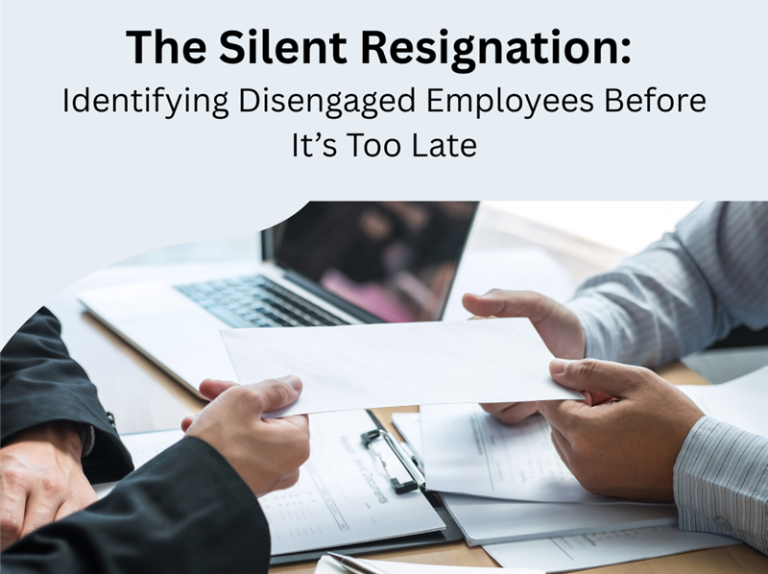The Silent Resignation: Identifying Disengaged Employees Before It’s Too Late

In the rush to recruit best-in-class talent and deliver business results, there's a quieter, but no less important issue that gets overlooked—employee disengagement. Unlike the commotion of a resignation letter or an exit interview, this movement whispers its existence: decreased passion, lack of effort, and a quiet withdrawal from ownership and initiative. Welcome to the era of silent resignation.
What Is Silent Resignation?
Silent resignation is not about workers leaving their job—it's about employees leaving on the job. They are people who have checked out emotionally. They physically arrive, do as they're told, and get by—however, their passion, creativity, and feeling of belonging have subtly vanished.
It is a close relative of the growing trend of quiet quitting, where workers do only what is needed, with no discretionary or emotional investment in their job. In both instances, the result is the same: an undercurrent of disengagement that quietly degrades performance and culture.
As business leaders and hiring managers, we tend to confuse presence with performance. But showing up without participating is the gradual development of job dissatisfaction and workplace burnout, both of which contribute to the larger issue of organizational stagnation.
The Hidden Cost to Organizations
Whereas employee turnover is quantifiable and apparent, employee disengagement is stealthy. Low-engaged teams have 18% lower productivity and 15% lower profitability, Gallup says. And whereas resignations are easier to track, diagnose, or reverse, these losses are more difficult to follow.
Disengaged employees:
-
Deliver just enough to avoid scrutiny
-
Avoid collaboration and learning opportunities
-
Stop sharing ideas or suggestions
-
Influence team morale negatively—often quietly
Early Warning Signs Hiring Managers Should Not Miss
Disengagement does not occur overnight. Here's what to watch out for:
-
Decline in discretionary effort: Workers no longer exceed their task assignments.
-
Lack of curiosity: No questions, no resistance, no initiative.
-
Emotional withdrawal: Minimal interaction, subdued enthusiasm, and staying away from team discussions.
-
Detachment from purpose: A palpable disconnect between individual work and company objectives.
-
Pattern of minimalism: Logging in, getting work done, and logging out—nothing more.
Why Hiring for Engagement Potential Is the New Imperative
Most hiring strategies focus on skill set and cultural fit. But in a post-pandemic, hybrid-first world, emotional engagement is the differentiator.
Instead of just evaluating credentials, forward-thinking hiring managers are asking:
-
Does this candidate exhibit an ownership mentality?
-
How do they talk about previous work challenges?
-
Are they inspired by the company’s mission, not just the compensation?
Engagement potential, such as learning agility, can forecast long-term performance and prevent quiet quitting and silent resignation from gaining traction.
Prevention is Better Than Cure: What Hiring Managers Can Do
-
Redesign Job Roles around Purpose
Make sure each role has a "why"—a clear alignment with the company mission. Purpose lowers job dissatisfaction.
-
Embed "Stay Interviews" into the Talent Lifecycle
Utilize these to learn what drives employees—and what doesn't.
-
Measure Engagement, Not Just Performance
Use engagement surveys and pulse check-ins. Get to the "why" behind the "what."
-
Rethink Onboarding
The first 90 days matter. Effective onboarding establishes early trust and emotional connection.
-
Make Managers Engagement Champions
Develop managers to promote psychological safety, recognition, and growth conversations—crucial antidotes to workplace burnout.
Out-of-the-Box Solutions You Can Try
-
Internal Mobility Match Days
Encourage employees to discover new roles that more closely align with their passions. Engagement wanes from lack of challenge—not ability.
-
Energy Mapping
Enable employees to monitor what work energizes or depletes them—an early warning sign of employee disengagement.
-
Reverse Feedback Loops
Permit teams to review and re-design elements of their work. Empowered workers hardly ever disengage.
In Conclusion: The Choice Is Silent or Strategic
Quiet resignation isn't an HR problem—it's a leadership one. When your best talent quietly disengages, it impacts innovation, morale, and long-term success.
Hiring managers have a special opportunity—not only to bring in the right talent, but to get them engaged in a way that stops employee turnover and creates strong, purpose-driven teams.
Let’s shift our focus from filling roles to building connections. Because keeping people engaged is just as vital as hiring them in the first place.


